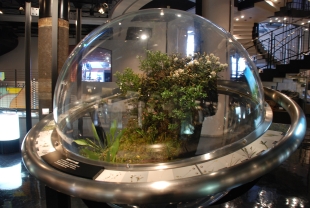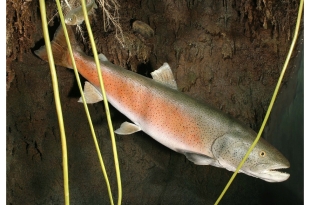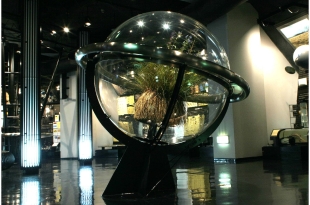1-6~8 Flora and Fauna in Kushiro1
1-6 Plants of Kushiro Wetlands
The 28,788 hectares comprising the Kushiro Wetlands are surrounded by primeval forest. More than 700 plant species grow within the wetlands. Many grow only in the Kushiro Wetlands, and some are surviving species from the last ice age.
Plants of the fens and bogs
The permanently wet fen areas are fed by groundwater, and are covered by reed grasses and sedges. The sphagnum bog, which is watered by frequent rainfall, supports forests of alder trees (Alnus japonica) and alpine and cold-climate plants. Water arum (Calla palustris), a small variety of calla lily, and the feathery white flowers of bogbean (Menyanthes trifoliata) bloom throughout the wetlands in summer.
Peat formation
Due to the cold, wet conditions, dead vegetation forms layers of peat rather than decomposing completely. The peat within the Kushiro Wetlands started forming some 3,000 years ago. With time, as it is compressed by layers of sediment, this peat will eventually turn into coal. This is how the coal deposits in the Kushiro area, which are mined to this day, formed over millions of years.

1-7 Sakhalin Taimen
The Sakhalin taimen (Hucho perryi, called ito in Japanese) is the largest species of freshwater fish in Japan. It once inhabited the northern part of the Tohoku region (northern Honshu), but the population is in decline, and the species is now found domestically only in Hokkaido.
A valuable resource
The Ainu, the indigenous people of Hokkaido, hunted the Sakhalin taimen for food and used its tough skin to make footwear. Over the past 40 years, the population of these fish has dwindled due to overfishing and loss of habitat, and the species is considered critically endangered.
Long-lived fish
The Sakhalin taimen can live up to 20 years. Unlike most salmon species, which spawn just once before dying, the Sakhalin taimen will spawn several times over the course of its life. The adults are usually a subdued brown color with a fine pattern of spots, but during the spawning season the males take on a reddish hue.
While mature Sakhalin taimens generally reach around 1 meter in length, the largest known example, caught in Hokkaido, was recorded at 2.1 meters. These fish are at the top of the food chain in the Kushiro Wetlands. Young Sakhalin taimens feed mostly on aquatic insects, while adults eat larger animals found around the water, including other fish, frogs, mice, and snakes.

1-8 Yachibozu Sedge Tussocks
The fens of the Kushiro Wetlands are dotted with clumps or tussocks of sedge called yachibozu that look almost like long-haired heads sticking up from the ground. As the sedge grows, the old leaves wither and spiky green new growth sprouts on the tops of the tussocks, creating successive layers of sedge leaves that hang down around the sides like hair.
Their startling height is caused by the combination of thick seasonal frost and thin snow cover on the wetlands. During cold winters, the roots of the tussocks are forced upward as the ground freezes. In spring, meltwater erodes the soil around the tussocks, exposing the roots further and making the tussocks appear taller. After about 40 years of ground freeze and erosion, some tussocks can reach 40 to 50 centimeters in height.
The yachibozu tussocks can be found in the Kushiro Wetlands as well as in the nearby Kiritappu Wetlands, which have a similar microclimate.

This English-language text was created by the Japan Tourism Agency.
このページに関するお問い合わせ
生涯学習部 博物館 博物館担当
〒085-0822 北海道釧路市春湖台1番7号 博物館
電話:0154-41-5809 ファクス:0154-42-6000
お問い合わせは専用フォームをご利用ください。
